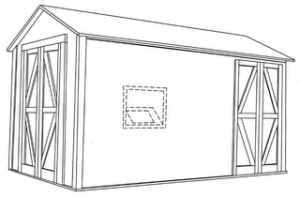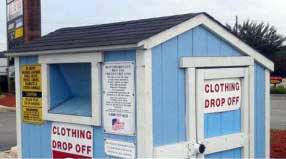In This Issue…
- TTAB Affirms Refusal of Nondistinctive Shed Design for Recycling Services
- More Recent Articles
- Search The TTABlog®
The Board affirmed a refusal to register the trade dress shown below, for “recycling collection center services for collecting clothing and textile goods for redistribution to further users,” finding that the proposed mark comprised a nondistinctive design lacking in acquired distinctiveness. Applicant’s reliance on Section 2(f) was a concession that the trade dress is not inherently distinctive. In re St. Pauly Textile, Inc., Serial No. 85769111 (June 7, 2016) [not precedential].
The mark, according to applicant, consists of a three-dimensional depiction of a drop off station in the form of a “decorative residential garden shed.” The shape of the deposit opening (shown in dashed line) does not form part of the mark.
Applicant relied its use of the purported mark for 18 years, an increase in its shed locations to 753 throughout New York and the Northeast, collection of several million pounds of clothing over the past five years, and certain media coverage. Applicant’s website included instructions to visitors to “Look for the St. Pauly Shed!”
Examining Attorney Tracy C. Fletcher submitted examples of third-party clothing drop-off stations that are similar to applicant’s trade dress, including this one:
Applicant argued that the evidence was sufficient to establish a prima facie case of acquired distinctiveness, contending that applicant “appears to be the sole user of a residential garden shed for recycling collection center services.” Accordingly, applicant asserted, a lower amount of evidence should be needed to establish acquired distinctiveness here.
The Board observed that the record included numerous examples of garden shed-like buildings used for clothing donation drop off receptacles, as well as examples of doors with diagonal braces and of gabled roofs.. Thus its is not “unique” or “unusual” to see a garden shed-type building used as a clothing drop-off receptacle. Applicant’s door design “is nothing more than a variation on common diagonal designs.”
Given the nature of applicant’s proposed mark, the Board found that a higher level of evidence is needed to establish a prima facie case of acquired distinctiveness. Applicant’s eighteen years of use was insufficient, in itself, to meet the requirement.
The evidence regarding expansion of use of applicant’s drop box may show only that its services are becoming increasingly popular, not that consumers perceive the shed design as a source indicator. Applicant’s supposed “look for” advertising simply says to look for its shed, but does not reference the design at issue. Thus customers could perceive this statement as saying “look for our donation drop off.” Similarly, the media refers to the drop off as a shed, with no mention of the applied-for design as identifying source.
Accordingly, based on all the evidence, the Board found that applicant had failed to establish that its applied-for design has acquired secondary meaning.
And so the Board affirmed the refusal.
Read comments and post your comment here.
Text Copyright John L. Welch 2016.
More Recent Articles
- TTAB Grants Cancellation Petition As a Sanction For Failure to Participate in Discovery Conference
- Ted Davis: Annual Review of U.S. Federal and State Case Law
- Precedential No. 15: TTAB Rejects Specimens of Use for Radio Broadcast Services
- Free Webinar: The TTABlogger on TTAB Developments, June 14th, 12-1 PM EST
- TTAB Test: Which of these Three Section 2(d) Refusals Was Reversed?



